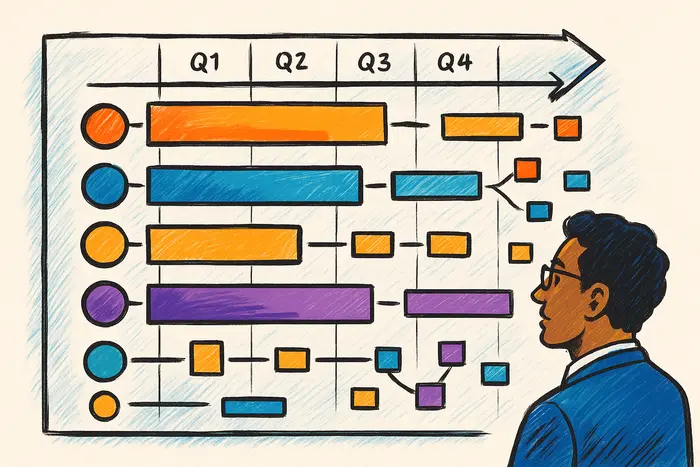A high-level roadmap is more than a plan—it’s a shared direction. It shows your team (and stakeholders) what matters most, when to focus on it, and how all the moving parts fit together.
But too many roadmaps are either too vague or too detailed. The sweet spot? A roadmap that’s strategic enough to guide decisions and simple enough to stay usable.
In this post, we’ll walk through how to build a high-level roadmap that truly guides execution.
What Is a High-Level Roadmap?
A high-level roadmap outlines major initiatives, milestones, and themes over a set period (often 6–18 months).
It’s not a task list. It’s a visual summary of your priorities and timeline. Think of it as a communication tool for strategy in action.
Why It Matters
- Aligns teams around common goals
- Clarifies priorities across functions
- Informs decisions when tradeoffs arise
- Sets expectations with leaders and stakeholders
Step-by-Step: How to Build One
Step 1: Define Your Timeframe
Choose a timeframe that fits your planning needs:
- 6 months for fast-moving teams
- 12–18 months for strategic planning
Break it into quarters or months depending on granularity needed.
Step 2: Identify Strategic Themes or Objectives
Start with 3–5 key focus areas. These are not tasks—they’re the big goals or outcomes you’re aiming for.
Examples:
- Improve user onboarding
- Launch a new product line
- Strengthen data security
Step 3: Map Major Initiatives to Each Theme
List major efforts or projects under each theme. Use broad strokes:
- Platform migration
- Internal process redesign
- Marketing campaign launch
You’re painting a picture, not filling a spreadsheet.
Step 4: Place Initiatives on the Timeline
Use quarters or months to place when each initiative starts, ends, or reaches milestones.
This helps teams understand dependencies, handoffs, and pacing.
Step 5: Keep It Visual and Simple
Use:
- Swimlane or column layouts
- Color-coded themes
- Minimal text (titles + short notes)
Tools: PowerPoint, Miro, Roadmunk, or simple spreadsheets.
Step 6: Share and Refine Collaboratively
Review with:
- Project leads
- Functional owners
- Executives
Make adjustments based on input. Keep it high-level, but credible.
Step 7: Review and Update Regularly
Roadmaps aren’t static. Schedule monthly or quarterly reviews to:
- Re-prioritize based on new info
- Track progress
- Communicate changes
Pro Tips
- Avoid overloading your roadmap—leave space to adjust
- Use milestones to break down large efforts
- Flag risks or unknowns with icons or notes
- Include a “parking lot” for future or deferred items
Summary: Clarity Over Complexity
A good roadmap aligns people, guides execution, and stays flexible.
Start with your big goals. Map the work that supports them. Share it early and often. And use it as a living tool to steer your strategy forward.
